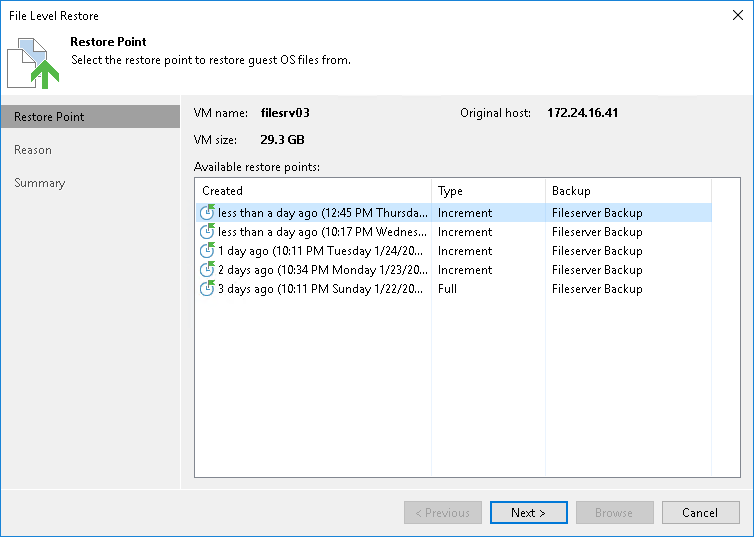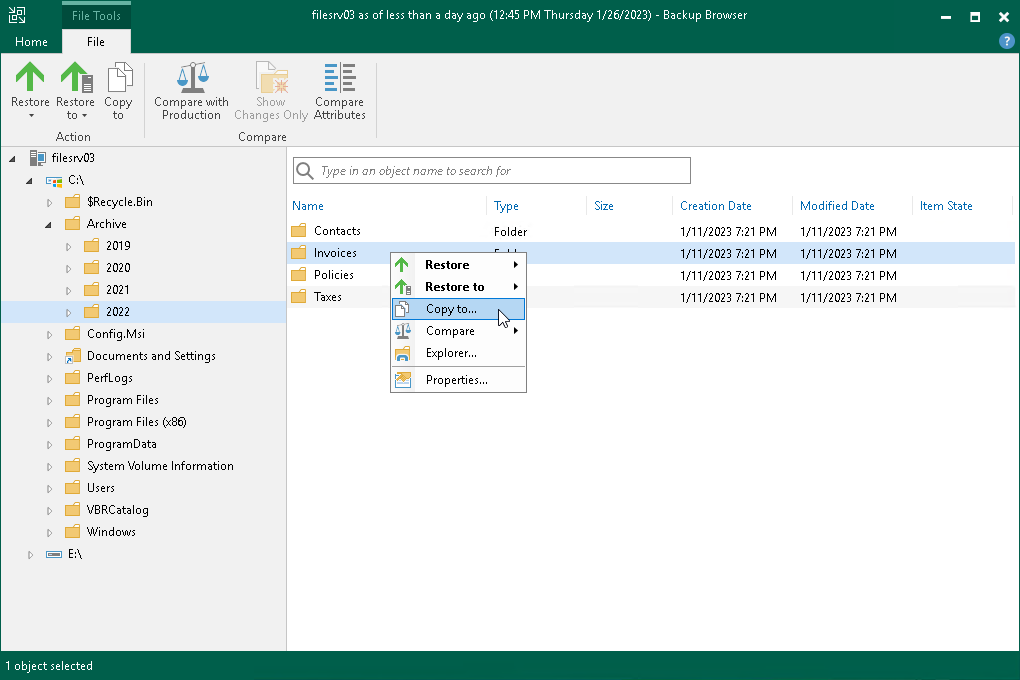Restoring VM Guest OS Files
You can restore individual Microsoft Windows guest OS files from backups of Microsoft Windows VMs.
During file-level recovery, Veeam Backup & Replication does not extract the VM image from the backup file. Virtual disks files from the backup are published directly into the Veeam backup server file system with the help of Veeam's proprietary driver. After VM disks are mounted, you can use the Veeam Backup Browser or Microsoft Windows Explorer to copy necessary files and folders to the local machine drive, save them in a network shared folder or point any applications to restored files and work with them as usual.
Note |
This section describes only basic steps that you must take to restore VM guest OS files. To get a detailed description of all settings of the restore process, see the Guest OS File Restore section in the Veeam Backup & Replication User Guide. |
To restore VM guest OS files of a Microsoft Windows VM from the backup:
- Open the Home view.
- Select the Backups node in the inventory pane. Expand the backup job in the working area, right-click the necessary VM in the backup job and select Restore guest files > Microsoft Windows.
- At the Restore Point step of the wizard, select the necessary restore point.

- At the Reason step of the wizard, specify the reason for future reference.
- Click Next and then click Browse to finish working with the File Level Restore wizard. Veeam Backup & Replication will mount VM disks from the backup to the backup server file system, and display the Veeam Backup Browser.
- In the Veeam Backup Browser, Veeam Backup & Replication will display the file system tree of the VM. Right-click the necessary file or folder and select the necessary option.
- To restore a file or folder to its original location on the original VM:
- Select Restore > Overwrite if you want to overwrite the original file or folder on the VM guest OS with the file or folder restored from the backup.
- Select Restore > Keep if you want to save a file or folder restored from the backup next to the original file or folder. Veeam Backup & Replication will add the _RESTORED_YYYYMMDD_HHMMSS postfix to the original file or folder name and save the restored file or folder in the same location where the original file or folder resides.
- To restore a file or folder to another VM in the Veeam backup infrastructure:
- Select Restore to > Overwrite if you want to overwrite the file or folder on the VM guest OS with the file or folder restored from the backup in case the file or folder with the same name resides on the target VM.
- Select Restore to > Keep if you want to save a file or folder restored from the backup next to the file or folder on the VM guest OS in case the file or folder with the same name resides on the target VM. Veeam Backup & Replication will add the _RESTORED_YYYYMMDD_HHMMSS postfix to the original file or folder name and save the restored file or folder in the specified location.
If you select one of this options, select the target VM and target path for the restored file or folder, and click OK.
- To restore to the original location only those files or folders that have changed on the original VM since the restore point for the backup was created, select Compare > Compare. Then right-click the file or folder and select one of the following options:
- Select Restore changed only > Overwrite if you want to overwrite the original file or folder on the VM guest OS with the file or folder restored from the backup.
- Select Restore changed only > Keep if you want to save a file or folder restored from the backup next to the original file or folder. Veeam Backup & Replication will add the _RESTORED_YYYYMMDD_HHMMSS postfix to the original file or folder name and save the restored file or folder in the same location where the original file or folder resides.
- To save a file or folder on the local machine or in a network shared folder, select Copy to, specify a path to the destination location and click OK.
To learn more, see the Finalize Restore section in the Veeam Backup & Replication User Guide.
